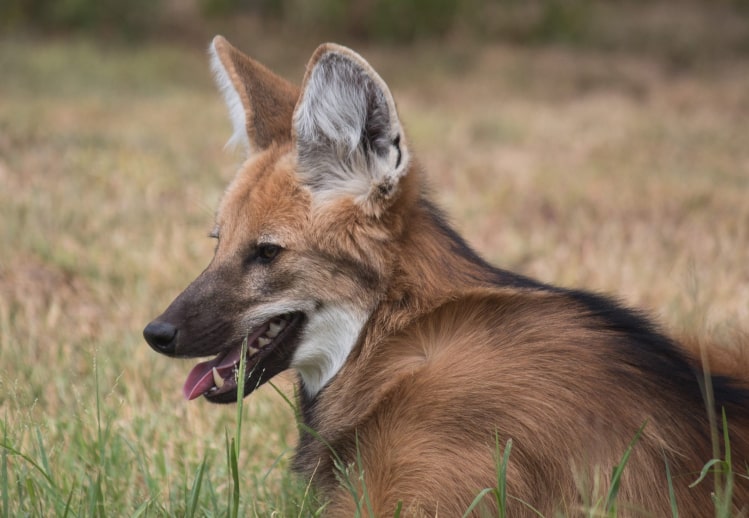The Maned Wolf, scientifically known as Chrysocyon brachyurus, is taxonomically distinctive, especial in appearance, and exhibits unique behavioral patterns. Named for the fringes of hair around its neck, the animal’s name alludes to it being a wolf. However, it is not closely related to other wolves; it is the sole species in the genus Chrysocyon, which directly translates to “golden dog.”
Often referred to as the fox on stilts due to its long legs and vulpine features, the Maned Wolf roams the grasslands of South America, asserting its ecological value and captivating wildlife enthusiasts and eco-activists alike.
Diet
The Maned Wolf is an omnivorous canid with a preference for both plant and animal matter. A significant portion of its diet is made of seasonally available fruits and vegetables, especially the small tomato-like fruit known as “wolf apple” (Solanum lycocarpum), which nourishes the wolf as it benefits from seed dispersal. Additionally, it hunts small mammals, birds, reptiles and insects.
Habitat
Maned Wolves have carved their niches on the open grasslands and scrub forests of central and southeastern Brazil. They can also be found in parts of Paraguay, Argentina, and Bolivia, making them the inhabitants of the largest biome of South America.
While this range is ideal for their growth and survival, the Wolves are currently experiencing devastating habitat loss.
Size and Weight
The Maned Wolf is the tallest of the wild canids, standing at about 90 cm at the shoulder and weighing between 20 to 25 kilograms. Its spindly legs aid in hunting expeditions, enabling it to see over tall grass while foraging for food and looking out for potential danger lurking in the distance.
Migration and Population Dynamics
The Maned Wolf exhibits seasonal movements within its territory in response to food availability and mating needs. While Maned Wolves are solitary animals, they pursue long-lasting, monogamous relationships where partners inhabit proximal territories but only come together during breeding.
Conservation Status
The Maned Wolf is classified as “Near Threatened” on the IUCN Red List. It faces menacing habitat loss due to extensive agriculture and infrastructural expansion.
Fast Facts
The Maned Wolf is one of a kind! It is not a wolf, fox, coyote, or dog, but an entirely unique canine.
The genus of the Maned Wolf is Chrysocyon, which means "golden dog" in Greek.
The strong scent you smell when around the Maned Wolf is actually how they mark their territory. Maned Wolves don't make much noise, so they communicate almost entirely through scent markings!
The Maned Wolf is omnivorous. It eats both plants and meat, and enjoys eating wild fruits from its home in South America.
FAQ
What is a maned wolf?
The maned wolf is the largest canid in South America, in countries like Brazil and Argentina. Despite its name, it is not closely related to true wolves or foxes. Recognizable by its long legs, reddish fur, and black mane, the maned wolf is an omnivore that eats small mammals, birds, insects, and fruits.
Are maned wolves dangerous?
Maned wolves are not considered dangerous to humans. These solitary and shy creatures are said to be wary of the presence of humans and tend to keep away from them. They primarily feed on small mammals, birds, insects, and plants. Maned wolves are more likely to run away than to become hostile or attack when encountered in the wild.
How tall is a maned wolf?
The maned wolf typically stands about 3 feet tall (90 cm) at the shoulder. This impressive height, due to its long legs, helps it navigate through tall grass in its native South American habitats.



